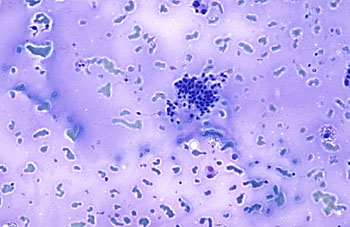Benign Thyroid Nodules Follow-Up Shows Favorable Prognosis
By LabMedica International staff writers
Posted on 25 Mar 2015
A majority of asymptomatic, benign thyroid nodules exhibited no significant change in size, after five years of follow-up, or actually decreased in size, and diagnoses of thyroid cancer were rare. Posted on 25 Mar 2015
The discovery of a thyroid nodule may be stressful for the patient, but more than 90% of the detected nodules are clinically insignificant benign lesions. Fine-needle aspiration cytology is the procedure of choice to identify suspicious lesions that require thyroid surgery.

Image: Fine needle aspiration cytology of a thyroid nodule showing benign epithelial cells, colloid, and occasional macrophages, typical of a colloid nodule (Photo courtesy of Shahidul Islam, MD, PhD).
Scientists at the Università di Roma Sapienza (Rome, Italy) and colleagues studied the frequency, magnitude, and factors associated with changes in thyroid nodule size. The study involved 992 patients with one to four asymptomatic, sonographically or cytologically benign thyroid nodules. Patients were recruited from eight hospital-based thyroid-disease referral centers in Italy between 2006 and 2008. Data collected during the first five years of follow-up, through January 2013, were analyzed. Size changes were considered significant for growth if an increase of 20% or more was recorded in at least two nodule diameters, with a minimum increase of two mm.
Fine-needle aspiration was performed or repeated when suspicious findings such as hypoechogenicity, irregular margins, taller-than-wide shape, intranodular vascular spots, microcalcifications, developed subsequent to the baseline ultrasound examination. Thyroid function tests were also measured. Nodule growth occurred in 153 patients (15.4%) and 174 of the 1,567 original nodules (11.1%) increased in size. Nodule growth was associated with presence of multiple nodules. In 184 individuals (18.5%), nodules shrank. Thyroid cancer was diagnosed in five original nodules (0.3 %), only two of which had grown. New nodules developed in 93 patients (9.3%), with detection of one cancer.
The authors noted that one of the goals of surveillance is the prompt detection and treatment of thyroid cancers that arise during follow-up or have been missed on the initial assessment. In the population they studied, these events were rare. Only two of the five diagnoses of cancer in an established nodule were preceded by significant growth of the cancerous nodule. Among patients with asymptomatic thyroid nodules that were sonographically or cytologically benign, the majority of nodules exhibited no significant size change during five years of follow-up or they actually decreased in size. The study was published on March 3, 2015, in the Journal of the American Medical Association (JAMA).
Related Links:
Università di Roma Sapienza












.jpg)
